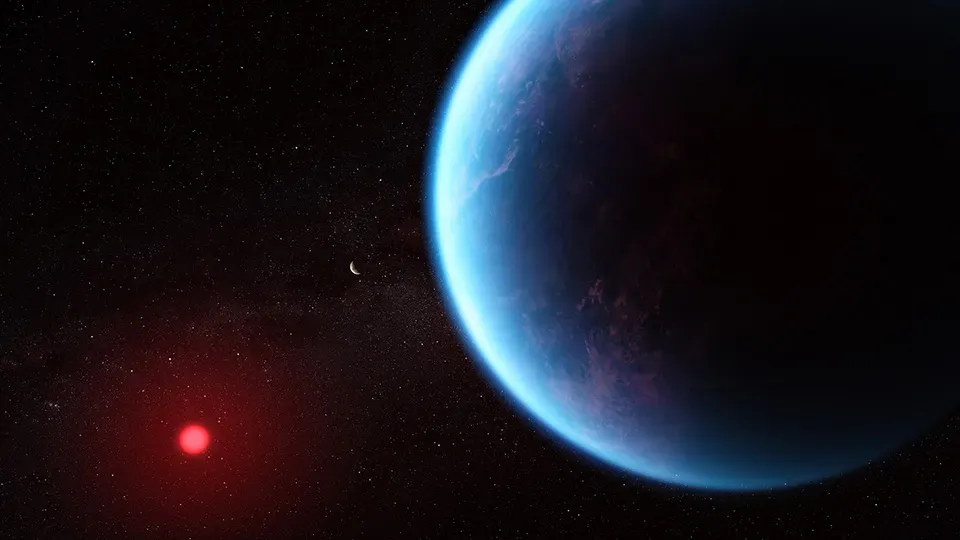A New Analysis Raises Doubts About Potential Hints of Life Recently Detected on a Distant Exoplanet
A New Analysis Raises Doubts About Potential Hints of Life Recently Detected on a Distant Exoplanet
Astronomers published evidence of possible biosignatures on the planet K2-18b earlier this month, but another look at the data suggests the finding could be statistical noise
An artist's concept of K2-18b, the exoplanet at the center of the debate
NASA / CSA / ESA / J. Olmsted
In mid-April, scientists led by the University of Cambridge in England published a paper detailing potential evidence of life on a distant planet called K2-18b. Now, astrophysicist Jake Taylor at the University of Oxford has published his own analysis of the data as a preprint paper on arXiv that has not been peer-reviewed—and he says those signs may not be there at all.
Using observations from the James Webb Space Telescope (JWST), the first study found possible signatures for compounds called dimethyl sulfide (DMS) and dimethyl disulfide (DMDS), which, on Earth, are only produced by life. Though these could have been generated in non-biological ways in space, the team suggested their detection offered the “strongest evidence yet” of life outside our solar system.
Taylor used a basic statistical test to re-analyze the JWST data, rather than looking specifically for DMS and DMDS. “I wanted to not ‘assume’ what molecules would be in the atmosphere,” he writes in an email to Nell Greenfieldboyce at NPR. “I directly analyzed the transmission spectrum that they analyzed in order to have a similar comparison.”
Taylor’s own tests came back with data points that looked like flat lines, indicating no detections of molecules. Had the points mapped out bell-shaped curves—called Gaussian distributions—that would have pointed to the presence of molecules. “This indicates that the data does not have the precision, yet, to detect a spectral feature [indicating a particular molecule],” says Taylor to Alex Wilkins at New Scientist.
With further research, more convincing signs of life might appear, Taylor tells CBC News’ Nicole Mortillaro. “We definitely would need more observations to get a better signal. And who knows, it might pop out, it might be there. It’s just right now, the signal-to-noise ratio is not definitive.”
The exoplanet K2-18b is between the sizes of Earth and Neptune, and it orbits a star roughly 124 light-years away. The Cambridge team suggests it’s a “Hycean” world—an ocean planet with a largely hydrogen atmosphere.
But this relates to another of Taylor’s critiques, which he shared on TikTok earlier this month. He argued the researchers should not have compared their detections to how molecules would behave in nitrogen-rich atmospheres like our own and instead should have considered how they would behave in a hydrogen-rich setting. “The data they use are not appropriate for these types of atmospheres,” Taylor said in the video.
Nikku Madhusudhan, the lead author of the first study, still stands behind his team’s findings. Taylor’s models, Madhusudhan tells New Scientist, are too simple to reflect the complexity of the real data. “The model itself is unphysical, as I have never seen a physically plausible model that can give rise to the Gaussian peaks and troughs in a transmission spectrum over this wavelength range,” he adds.
“There is nothing in this paper that worries me or seems relevant to the discussion about our result. I am only slightly surprised that the bar is so low for a rebuttal!” Madhusudhan adds in an email to NPR.
Taylor, on the other hand, tells New Scientist that these simple models are often used to identify chemicals such as sodium in atmospheres.
Still, in the Cambridge team’s original paper, they noted that more research will be necessary to verify their findings. They called for “a dedicated community effort in multiple directions—observational, theoretical and experimental,” to test their conclusions. The researchers’ detection reached what’s known as the three-sigma level of statistical significance—or a 0.3 percent chance that the observation is a fluke. In general, a more rigorous five-sigma detection represents a statistically significant finding, writes Brandon Specktor for Live Science.
Kevin Stevenson, an astronomer at Johns Hopkins University who was not involved in either study, tells NPR that this re-analysis is important, “because it carries the frustrations expressed by many in the exoplanet community.”
“Just like the boy that cried wolf, no one wants a series of false claims to further diminish society’s trust in scientists,” he adds. “Context is important when it comes to science communication, particularly for a hot-button topic like the search for life beyond Earth, and we need to be responsible stewards in that respect.”
The full set of JWST data used by Madhusudhan and his team is now public, so more studies like Taylor’s will likely be published in the coming weeks. But perhaps the best way to settle this debate, as astronomers have noted, is collecting more observations.
Get the latest stories in your inbox every weekday.


